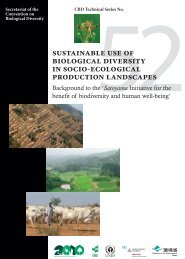INDIAN SCIENCE CONGRESS - India Environment Portal
INDIAN SCIENCE CONGRESS - India Environment Portal
INDIAN SCIENCE CONGRESS - India Environment Portal
You also want an ePaper? Increase the reach of your titles
YUMPU automatically turns print PDFs into web optimized ePapers that Google loves.
Section XIV : Plant Sciences 7<br />
of mushrooms specially Boletes. Prior to Dr. Roy Watling’s visit one of his students<br />
Dr. Alexander, who worked on the mycorrhiza, visited Shimla as a guest of the<br />
Conifer Research Centre, now Himalayan Forest Research Institute. It was he who<br />
for the first time introduced me to mycorrhiza; these visits led to my ‘symbiotic<br />
association and journey with mushrooms and mycorrhiza’.<br />
Since Agaricales is a large assemblage of mushrooms and toadstools, comprising<br />
more than 20 families (Singer, 1986), instead of initiating work on all families,<br />
I decided to begin family wise survey, starting with the family Boletaceae (Sharma<br />
and Lakhanpal, 1981; Sharma, 1980, Sharma, 1986; Sagar 1988; Lakhanpal, 1996).<br />
In the family Boletaceae 7 genera and 57 species were recorded. The seven<br />
genera recorded are Austroboletus (1) Boletus (37), Gyproporus (2), Leccinum<br />
(6), Strobilomyces (3), Suillus (5) and Tylopilus (3). This work included 5 new<br />
species and an equal number of new varieties. The work on Boletaceae was<br />
compiled into a monograph : Mushrooms of <strong>India</strong>-Boletaceae (Lakhanpal, 1996)<br />
The systematics was accompanied by supplementary data on edible species and 22<br />
species in Boletaceae were found to be edible. Among these Boletus edulis was<br />
the species of choice. Besides a new species B. hoarkii sp. nov. was also<br />
identified. About 22 species of boletes were identified to be mycorrhizal with<br />
different predominant tree species.<br />
In 1981, the mushroom exploration was extended to the families Amanitaceae,<br />
Russulaceae and Cantharellaaceae. The collections were primarily made from<br />
Shimla and adjoining areas. In these collections the genus Amanita in Amanitaceae<br />
was represented by 12 species; genus Lactarius and Russula in Russulaceae by<br />
14 and 22 species, respectively and genus Cantharellus and Craterellus by 5 and<br />
2 species respectively (Bhatt, 1986; Bhatt and Lakhanpal, 1988a, b,c). With the<br />
sanctioning of a project on mushrooms by the Department of Science and<br />
Technology (GOI) in 1983, work was extended to different parts of Himachal<br />
Pradesh and 6 more species in Amanitaceae were collected bringing the total<br />
number to 18 in the N. W. Himalayas and 25 in <strong>India</strong> (Kumar, 1987). This resulted<br />
in the publication of “Amanitaceae of <strong>India</strong>” (Kumar et al. , 1990). This work<br />
included 4 taxa new to science, 13 species were observed to be mycorrhizal with<br />
different trees species. Out of these only Amanita caesaria and A. vaginata were<br />
found to be edible and consumed locally by the people. Typical A. muscaria was<br />
not recorded however; only A. muscaria var. flavivolvata was recorded. Similarly<br />
the exploration was also intensified on Russulaceae and Cantharellaceae (Bhatt,<br />
1986).
















